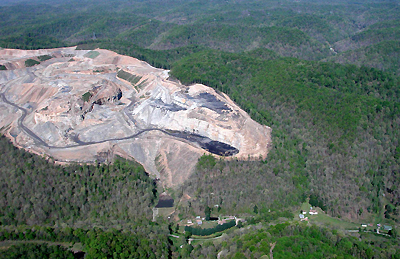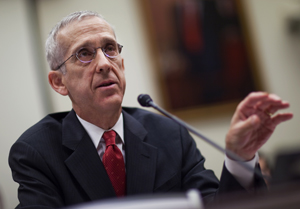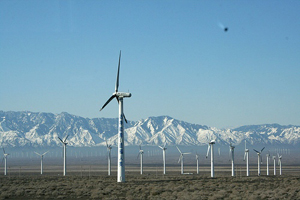|

|
|
By Marianne Lavelle
The Center for Public Integrity
Saturday, Nov 7, 2009
 |
| Mountain top strip mining for coal endangers the earth, air and water of Appalachia. |
|
In
the poor, but mineral-rich mountains of the eastern United States known
as Appalachia, coal millionaire Don Blankenship hosts a rally
for “Friends of America” to hear country music and “learn how
environmental extremists and corporate America are both trying to
destroy your jobs.”
On the other side of the globe, with an
eye on his venture in an Australian port town known both as a gateway
to the Great Barrier Reef and a smokestack industry haven, aluminum
billionaire Oleg Deripaska battles that nation’s program to address
climate change as “destructive for jobs, destructive for new and
existing investment.”
And in China, ambitious renewable
electricity plans look like an important step toward tackling global
warming, but progress lags due to built-in and deeply entrenched
favoritism for cheaper fossil fuel. “There’s no need for anyone to get
over-excited,” says Lu Qizhou, the government appointee who heads
China’s big power industry group. Change from the coal-fired energy
system will be slow and won’t outpace “the market’s ability to cope.”
Around
the world the story is the much same. Wherever nations have taken the
first modest steps to stave off a looming environmental calamity for
future generations, they’ve triggered a backlash from powers rooted in
the economy of the past. Opponents of climate action may have different
methods as they pressure different capitals, but the message is
consistent: Be afraid that a cherished way of life may be lost. Be
afraid that a better standard of living will never be had.
From Kyoto to Copenhagen
Those fears will be center stage as negotiators from 192 nations gather in Copenhagen
this December to forge one of the most challenging multi-national
agreements ever. The daunting task: to reduce the pollution that the
scientific consensus says has imperiled the planet — emissions from the
burning of oil, coal, and gas that have fueled all economic development
since the Industrial Revolution.
 |
| U.S. climate envoy Todd Stern, testifying before a House panel in September, will likely go to Copenhagen without firm commitments, as Congress continues to grapple with legislation to cut emissions.(Jim Lo Scalzo) |
|
The world, of course, already has a plan in place to cut carbon dioxide and other greenhouse gases — an agreement
reached at Kyoto, Japan in 1997. But that deal was marked by the
decision made early on that developing countries, like China and India,
where millions of people still lived without electricity, would not
have binding obligations to reduce emissions. That accommodation was
made in recognition of the need to eradicate poverty in countries where
per capita emissions remain low, and that the bulk of greenhouse gases
already in the atmosphere came from countries that grew wealthy in
fossil-fueled economies. But as a result, Kyoto simply exempted the
largest future source of the problem; the International Energy Agency
projects that 97 percent of the increase in global emissions between
now and 2030 will come from developing countries. And Kyoto’s rich-poor
nation divide on obligations made it politically impossible to get the
United States — the largest historic source of greenhouse gas emissions
— to agree to participate.
Kyoto always was seen as just a
first step, with new negotiations needed on a second phase of
commitments to begin in 2012. But those talks for a new global warming
agreement at Copenhagen have become freighted with significance, due to
hope for both new leadership from the United States and for better
ideas on how to bridge the gap between the world’s haves and have-nots.
“Copenhagen is not just about negotiations, it’s a political policy
event that will have a big impact on global consciousness on the state
of climate change,” says Rafe Pomerance, president of the U.S.
non-profit Clean Air-Cool Planet
and a former climate negotiator as deputy assistant secretary of state
during the Clinton Administration. “It’s so big that it’s driving
activity all over the world. And the process itself is almost as
important as the outcome.”
It was in anticipation of
Copenhagen that the leaders of the developed countries known as the
Group of Eight (or G8) pledged at their July meeting in Italy to work
to keep temperatures from rising more than 3.6 degrees Fahrenheit (2
degrees Celsius) over pre-industrial levels. Beyond that threshold lie
grave dangers for civilization, says the Intergovernmental Panel on Climate Change
(IPCC), the United Nations network of more than 2,000 scientists that
reports the consensus view of peer-reviewed science. Risks include
global sea-level rise, drought that reduces world food supply, loss of
fresh water, and increased wildfire, insects, and disease.
The Global Lobby: Vested Interests
The G8 agreed that emissions
should be cut 80 percent or more below 1990 levels by 2050, in line
with IPCC targets, but the world leaders declined to name any
short-term goals. And the IPCC views near-term action as crucial. In
fact, it specifies that global emissions — which have been inexorably
rising — should begin to fall by 2015 if the world hopes to stabilize
the atmosphere. (Even that stabilizing point — at 450 parts per million
(ppm) carbon dioxide — is well below the more aggressive target of 350
ppm that NASA scientist James Hansen and demonstrators around the world
have called for.)
In fact, none of the emissions reduction
targets for Copenhagen announced so far by wealthy countries meets the
25 to 40 percent below 1990 levels by 2020 that the IPCC said would be
necessary to achieve stabilization. (See “Climate Goals Fall Short” to
the right.) The cuts being eyed in the United States and Canada, for
example, are just a few points less than a bare return to 1990 levels.
Australia, Japan, and the European Union have voiced a willingness to
do more, but contingent on action from other nations. Japan,
especially, has an eye on the developing world. And that’s the crux of
the stalemate, because China, India, and the other developing nations
refuse binding emissions reductions.
This climate deadlock
is nearly always framed as the clash between the national interests of
wealthy countries that want to maintain their standard of living and
the national interests of developing countries that need to lift
millions out of poverty. But the arguments of the rich and poor nations
actually have the same underpinning — that cheap fossil-fueled energy
and other carbon-intensive activities like deforestation are keys to
economic success. And all of those governments — no matter how far
north or south — are feeling the pressure of the interests that have
mobilized to keep this conviction alive.
In China, for
instance, wind turbines rising against the Xinjian Province mountains
have become an iconic image of that country’s growing commitment to
cleaner energy. Severe crippling ice storms that marred Chinese New
Year in early 2008 touched off a national dialogue on climate change.
The government’s goal is to achieve 20 percent renewable power by 2020,
on the road to which it has doubled its installed wind power in each of
the past four years. But China is also building coal plants so fast
that it still gets just one percent of electricity from wind. The
reality is that only one of the top 10 power companies — all of them
state-owned enterprises — will meet the government’s interim goal of
three percent renewables by 2010. The power company executives, all
quasi-governmental officials, have resisted proposals to help
renewables by raising the price of coal. “There don’t need to be
‘lobbyists’ when discussions can happen directly through the Party,”
says Beijing-based political commentator Zhao Jing.
The
pressure is less subtle in democratic developing countries. For
example, Brazilian President Luiz Inacio Lula da Silva recently said he
will go to Copenhagen with an offer to reduce the pace of deforestation
in the Amazon rain forest — one of the world’s most important natural
absorbers of carbon dioxide — by 80 percent by 2020. But Carlos Minc,
Lula’s environment minister, who has hands-on responsibility for the
policy, has faced an onslaught from the powerful agriculture industry
and its allies in elected office who want to maintain free rein on land
use. One governor even threatened him with rape. “Many of those
industries talk about zero deforestation, but when we press them they
want to kill us, or make speeches declaring me persona non grata,” he
says. “They call me to speak in the Senate or the House and I stay for
five hours under a massacre. They’re favorable to zero deforestation,
provided it doesn’t affect …their own land.”
Rich Man, Poor Man
The principle that developing
countries shouldn’t have binding treaty obligations is dearly held by
businesses that have the ear of government in those nations. In Delhi,
India, Bharat Wakhlu, resident director of the powerful Tata Group
— that nation’s largest business conglomerate with nearly 100 companies
from power generation to autos — says the company recognizes it has a
role in addressing global warming. But, he added, “We believe in a
‘common but differentiated’ approach, as we have to retain our
competitiveness as well as ensure the planet is safe.” United Nations
climate change convention documents dating back as far as 1992 use the
phrase “common but differentiated” to describe the responsibilities of
rich and poor nations; the key differentiation has been that only
wealthy nations need to cut emissions.
Juan C. Mata
Sandoval, Mexico’s top climate official and a negotiator for
Copenhagen, is frank that one of the business lobby’s chief concerns
has been that his nation remain a “non-Annex 1” country — one without
required emissions cuts. “We need to communicate with them constantly
to explain how the negotiations are going,” he said. “The private
sector also wants a voice and an opinion on how much is Mexico going to
put on the table.”
But in its own way, Mexico — like China,
India, and Brazil — is addressing climate change. Mexico has a national
climate change plan with 86 specific goals it says will slow the growth
of its carbon emissions, now at about 700 megatons a year, by about 50
megatons by 2012. In absolute terms, Mexico’s carbon output would still
rise in the short term, but the country also has mapped out a long-term
pathway to reduce its emissions — if it receives technical and
financial support from developed countries. Mexico has proposed a
global Green Fund to which all nations would contribute based on a
formula that takes into account all the factors that have divided rich
and poor nations — both historical and current emissions, both gross
domestic product and population.
It’s just one of the ideas
that have been floated for breaking the climate stalemate. The idea of
“nationally appropriate mitigations actions” — cuts that make sense
given a country’s state of development — was actually included in the
roadmap for the Copenhagen talks that was adopted in Bali in 2007.
Experts credit the Center for Clean Air Policy
(CCAP), a Washington non-profit that has been working to bridge the
rich-poor nation climate divide, for promoting the concept. In
dialogues with 30 developing countries, CCAP found that many were
taking steps to reduce electricity use and increase renewable power.
“They had all these things they were doing on their own — not for money
from [developed countries] but for good reasons in their own
countries,” says CCAP President Ned Helme. “We were trying to figure
out a way to build on that momentum.”
 |
| China’s wind turbines are a symbol of the government’s growing commitment to renewable energy, but the country still gets just one percent of its electricity from wind. (Kaj Iverson) |
|
South Korea and South Africa
have proposed a system for harnessing that progress by tracking the
actions by developing countries. Numerous world leaders have been
working on ways that moves by the developing world could be made
measurable, reportable, and verifiable so they can be built into an
international agreement. U.S. climate negotiator Todd Stern sees these
developments as cause for optimism, even while many view the Copenhagen
talks as on a path toward stalemate. “All the major economies are
prepared to lay down significant low-carbon development plans,” he said
at a recent U.S.-India energy forum in Washington. “This is big news.
It’s never happened before. It’s important stuff.”
But it’s
a headline that hasn’t registered in the climate politics of the United
States or other developed nations. Europe has a history of green party
political power not found across the Atlantic, and on paper it has
ambitious climate goals for 2020. But the actual emissions cuts
contemplated within the E.U.’s borders were significantly reduced due
to lobbying by heavy industries that protested they would face unfair
competition from the developing world, especially amid the economic
downturn.
Those themes are echoed by representatives of the
so-called BINGOs, the Business and Industry Non-Governmental
Organizations, that attend the negotiating sessions all over the world
and have been a permanent presence in the United Nations’ efforts on
climate change for more than 20 years. These climate uber-lobbyists
aren’t there to make a hard-sell pitch, but to get to know the key
players who congregate around the treaty talks, to ease their way into
more specific policy discussions back home, where the real decisions
are made. “We loiter,” John Scowcroft of the European Union of the
Electricity Industry remarked at the recent talks in Bangkok. “It’s
loitering with intent.”
Back home, manufacturing
powerhouses like the aluminum industry of Australia argue they will
lose jobs if developing country competitors like China don’t face the
same regime of emissions cuts. Such business opposition helped defeat
climate legislation in the Australian Senate in August, even though
polling showed a majority of citizens favored it.
“An Epic Struggle”
 |
| Climate change is blamed for extreme weather plaguing Australia this year, including deadly wildfires, epic drought, and dust storms that turned the sky into a red glow. (Sydney Morning Herald) |
|
The business lobby has not
been shy about pressing its views in Australia. The top 20 companies
that are expected to receive assistance from the Australian government
to reduce emissions employ 28 lobbying firms. More than half the
lobbyists are former politicians, senior government bureaucrats, or
political advisors. The business lobby has to be strong indeed to slow
climate progress in Australia, the hottest and driest continent on
earth, which is amid a years-long drought that contributed to deadly
wildfires and is watching its climate-stressed tourism jewel, the Great
Barrier Reef, on course to be “functionally extinct” by 2050. The
administration of Prime Minister Kevin Rudd, whose first official act
in office in 2007 was to ratify Kyoto, is working with opponents on
business-friendly amendments aiming to build support for a new vote on
the legislation before Copenhagen.
In the United States, the Senate also is advancing its climate legislation in the Copenhagen run-up, but popular support for the measure is easily shaken. Although a Washington Post/ABC
News poll showed that three quarters of the Americans think the federal
government should regulate greenhouse gases, only 52 percent supported
the cap-and-trade program policymakers have chosen to address the
problem. Only 44 percent said they would back a cap-and-trade system if
it boosted monthly electricity bills by $25. Forty-four percent of
Americans rated global warming as a “very serious” problem in the Pew
Global Attitudes Project poll, putting the United States near the
bottom of 25 nations surveyed, along with fellow major polluter China,
at 30 percent. Some 90 percent of Brazilians, 68 percent of the French
population, 67 percent of people in India, and 65 percent of Japanese
viewed the issue as “very serious” in the international survey. A poll
by the Pew Research Center for the People & the Press
found roughly half of Americans favor setting limits on carbon
emissions and making companies pay for their emissions, even if this
may lead to higher energy prices. But the poll’s strongest finding was
that the issue had not even registered with the public, with 55 percent
said they had heard nothing at all of Congress’s efforts to address the
problem.
If the public is unaware, more than 1,150 companies
and advocacy groups are very tuned in, and they have deployed about
2,810 climate lobbyists to Capitol Hill, an increase of more than 400
percent from six years earlier, according to an analysis of disclosures
filed with the Senate Office of Public Records. Spending on the
lobbying this year so far in the United States is at least $47 million.
Senate advocates aim to build support much as it was achieved in the
legislation that narrowly passed the House this summer — by giving a
boost to businesses that fear they’ll be hurt by measures raising the
cost of the coal that supplies half the nation’s electricity. But the
concessions have not won over opponents like Don Blankenship, chief
executive of Massey Energy,
the largest coal producer in central Appalachia, who forcefully
disputes the science of global warming. Although that makes him an
outlier in the public debate, his argument that the bill will cost jobs
at the same time “it will increase global pollution by moving
production to unregulated countries like China” causes worry on Capitol
Hill.
Blankenship is just one of the business opponents who
have worked to rally citizen ire — a campaign that has resulted in
hundreds of alarmed phone calls to Senate offices. Given the power of
industry lobbying in Washington, advocates see the best hope for the
legislation’s passage as the competing U.S. businesses that support
action, ranging from power companies that want predictable energy
policy to high-tech firms that aim to market climate solutions.
Dan Reicher, director of climate change and energy initiatives
at Google, who also was a member of President Barack Obama’s transition
team, is confident climate action can gain support in the U.S.
Congress, if it has plenty of flexibility and opportunity for
businesses. But he is under no illusions it will be easy. “It shouldn’t
be a surprise to anyone that there’s a major proportion of our economy
that’s built around traditional energy supplies, and would indeed feel
some impact from controlling carbon emissions,” he says. “So that’s
what has to be sorted out politically.” At a recent conference in
Washington on energy efficiency — a pursuit Google aims to advance by providing
people real-time home electricity information — Reicher summed up the
climate change politics succinctly: “This is going to be an epic, epic
struggle.”
The Center for Public Integrity
 Print This Print This

|
If you appreciated this article, please consider making a donation to Axis of Logic.
We do not use commercial advertising or corporate funding. We depend solely upon you,
the reader, to continue providing quality news and opinion on world affairs. Donate here
|
 |
World News

|

